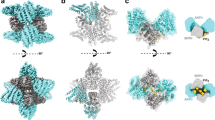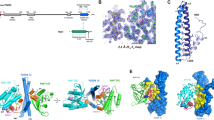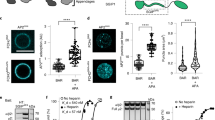Abstract
Adaptor proteins load transmembrane protein cargo into transport vesicles and serve as nexuses for the formation of large multiprotein complexes on the nascent vesicles. The γ-adaptin ear (GAE) domains of the AP-1 adaptor protein complex and the GGA adaptor proteins recruit accessory proteins to these multiprotein complexes by binding to a hydrophobic motif. We determined the structure of the GAE domain of human GGA3 in complex with a peptide based on the DFGPLV sequence of the accessory protein Rabaptin-5 and refined it at a resolution of 2.2 Å. The leucine and valine residues of the peptide are partly buried in two contiguous shallow, hydrophobic depressions. The anchoring phenylalanine is buried in a deep pocket formed by the aliphatic portions of two conserved arginine residues, along with an alanine and a proline, illustrating the unusual function of a cluster of basic residues in binding a hydrophobic motif.
This is a preview of subscription content, access via your institution
Access options
Subscribe to this journal
Receive 12 print issues and online access
$189.00 per year
only $15.75 per issue
Buy this article
- Purchase on Springer Link
- Instant access to full article PDF
Prices may be subject to local taxes which are calculated during checkout






Similar content being viewed by others
References
Kirchhausen, T. Adaptors for clathrin-mediated traffic. Annu. Rev. Cell Dev. Biol. 15, 705–732 (1999).
Robinson, M.S. & Bonifacino, J.S. Adaptor-related proteins. Curr. Opin. Cell Biol. 13, 444–453 (2001).
Boman, A.L., Zhang, C.J., Zhu, X. & Kahn, R.A. A family of ADP-ribosylation factor effectors that can alter membrane transport through the trans-Golgi. Mol. Biol. Cell 11, 1241–1255 (2000).
Dell'Angelica, E.C. et al. GGAs: a family of ADP ribosylation factor-binding proteins related to adaptors and associated with the Golgi complex. J. Cell Biol. 149, 81–94 (2000).
Hirst, J. et al. A family of proteins with γ-adaptin and VHS domains that facilitate trafficking between the trans-Golgi network and the vacuole/lysosome. J. Cell Biol. 149, 67–80 (2000).
Poussu, A., Lohi, O. & Lehto, V.P. Vear, a novel Golgi-associated protein with VHS and γ-adaptin 'ear' domains. J. Biol. Chem. 275, 7176–7183 (2000).
Nielsen, M.S. et al. The sortilin cytoplasmic tail conveys Golgi-endosome transport and binds the VHS domain of the GGA2 sorting protein. EMBO J. 20, 2180–2190 (2001).
Puertollano, R., Aguilar, R.C., Gorshkova, I., Crouch, R.J. & Bonifacino, J.S. Sorting of mannose 6-phosphate receptors mediated by the GGAs. Science 292, 1712–1716 (2001).
Zhu, Y., Doray, B., Poussu, A., Lehto, V.P. & Kornfeld, S. Binding of GGA2 to the lysosomal enzyme sorting motif of the mannose 6-phosphate receptor. Science 292, 1716–1718 (2001).
Takatsu, H., Katoh, Y., Shiba, Y. & Nakayama, K. Golgi-localizing, γ-adaptin ear homology domain, ADP-ribosylation factor-binding (GGA) proteins interact with acidic dileucine sequences within the cytoplasmic domains of sorting receptors through their Vps27p/Hrs/STAM (VHS) domains. J. Biol. Chem. 276, 28541–28545 (2001).
Slepnev, V.I. & De Camilli, P. Accessory proteins in clathrin-dependent synaptic vesicle endocytosis. Nat. Rev. Neurosci. 1, 161–172 (2000).
Benmerah, A., Begue, B., Dautry-Varsat, A. & Cerf-Bensussan, N. The ear of α-adaptin interacts with the COOH-terminal domain of the Eps 15 protein. J. Biol. Chem. 271, 12111–12116 (1996).
Brett, T.J., Traub, L.M. & Fremont, D.H. Accessory protein recruitment motifs in clathrin-mediated endocytosis. Structure 10, 797–809 (2002).
Owen, D.J. et al. A structural explanation for the binding of multiple ligands by the α-adaptin appendage domain. Cell 97, 805–815 (1999).
Owen, D.J., Vallis, Y., Pearse, B.M., McMahon, H.T. & Evans, P.R. The structure and function of the β2-adaptin appendage domain. EMBO J. 19, 4216–4227 (2000).
Mattera, R., Arighi, C.N., Lodge, R., Zerial, M. & Bonifacino, J.S. Divalent interaction of the GGAs with the Rabaptin-5-Rabex-5 complex. EMBO J. 22, 78–88 (2003).
Mills, I.G. et al. EpsinR: an AP1/clathrin interacting protein involved in vesicle trafficking. J. Cell Biol. 160, 213–222 (2003).
Liu, W.W.Y. et al. Binding partners for the COOH-terminal appendage domains of the GGAs and γ-adaptin. Mol. Biol. Cell 14, 2385–2398 (2003).
Duncan, M.C., Costaguta, G. & Payne, G.S. Yeast epsin-related proteins required for Golgi-endosome traffic define a γ-adaptin ear-binding motif. Nat. Cell Biol. 5, 77–81 (2003).
Kent, H.M., McMahon, H.T., Evans, P.R., Benmerah, A. & Owen, D.J. γ-adaptin appendage domain: structure and binding site for Eps15 and γ-synergin. Structure 10, 1139–1148 (2002).
Nogi, T. et al. Structural basis for the accessory protein recruitment by the γ-adaptin ear domain. Nat. Struct. Biol. 9, 527–531 (2002).
Page, L.J., Sowerby, P.J., Lui, W.W. & Robinson, M.S. γ-synergin: an EH domain-containing protein that interacts with γ-adaptin. J. Cell Biol. 146, 993–1004 (1999).
Collins, B.M., Praefcke, G.J.K., Robinson, M.S. & Owen, D.J. Structural basis for binding of accessory proteins by the appendage domain of GGAs. Nat. Struct. Biol. advance online publication, 13 July 2003 (doi:10.1038/nsb955).
Sheffield, P., Garrard, S. & Derewenda, Z. Overcoming expression and purification problems of RhoGDI using a family of 'parallel' expression vectors. Protein Expr. Purif. 15, 34–39 (1999).
Dell'Angelica, E.C., Klumperman, J., Stoorvogel, W. & Bonifacino, J.S. Association of the AP-3 adaptor complex with clathrin. Science 280, 431–434 (1998).
Otwinowski, Z. & Minor, W. Processing of X-ray diffraction data collected in oscillation mode. Methods Enzymol. 276, 307–326 (1997).
Terwilliger, T.C. & Berendzen, J. Correlated phasing of multiple isomorphous replacement data. Acta Crystallogr. D 52, 749–757 (1996).
Terwilliger, T.C. Maximum-likelihood density modification. Acta Crystallogr. D 56, 965–972 (2000).
Jones, T.A., Zou, J.Y., Cowan, S.W. & Kjeldgaard, M. Improved methods for building protein models in electron density maps and the location of errors in these models. Acta Crystallogr. A 47, 110–119 (1991).
Brunger, A.T. et al. Crystallography & NMR system: A new software suite for macromolecular structure determination. Acta Crystallogr. D 54, 905–921 (1998).
Kraulis, P.J. MOLSCRIPT: a program to produce both detailed and schematic plots of protein structures. J. Appl. Crystallogr. 24, 946–950 (1991).
Merritt, E.A. & Bacon, D.J. Raster3D photorealistic molecular graphics. Methods Enzymol. 277, 505–524 (1997).
Acknowledgements
We thank T. Earnest and the staff of the HHMI beamline 8.2.1, Advanced Light Source, Lawrence Berkeley Lab (Berkeley, California) for assistance with data collection, S. Sechi for assistance with mass spectrometry, and X. Zhu for expert technical assistance.
Author information
Authors and Affiliations
Corresponding author
Ethics declarations
Competing interests
The authors declare no competing financial interests.
Supplementary information
Rights and permissions
About this article
Cite this article
Miller, G., Mattera, R., Bonifacino, J. et al. Recognition of accessory protein motifs by the γ-adaptin ear domain of GGA3. Nat Struct Mol Biol 10, 599–606 (2003). https://doi.org/10.1038/nsb953
Received:
Accepted:
Published:
Issue Date:
DOI: https://doi.org/10.1038/nsb953
This article is cited by
-
The hepatitis B virus preS1 domain hijacks host trafficking proteins by motif mimicry
Nature Chemical Biology (2013)
-
The retromer subunit Vps26 has an arrestin fold and binds Vps35 through its C-terminal domain
Nature Structural & Molecular Biology (2006)
-
Life of a clathrin coat: insights from clathrin and AP structures
Nature Reviews Molecular Cell Biology (2006)
-
Arf1
AfCS-Nature Molecule Pages (2005)
-
γ-BAR, a novel AP-1-interacting protein involved in post-Golgi trafficking
The EMBO Journal (2005)



